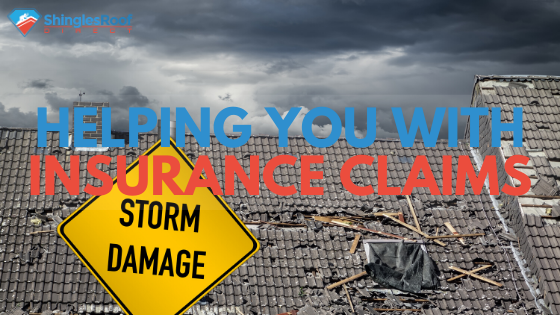Acts of nature like thunderstorms, hail storms, straight-line winds are calamities we cannot avoid. They can easily cause damage to any residential or commercial roof. In this case, we definitely need to get a roof replacement or a roof repair, whether we like it or not.
Data acquired from www.verisk.com showed that North Carolina ranks ninth in states likeliest to be hit by damaging hail. In fact, according to www.stormersite.com, there had been two Hail Storms in North Carolina in the month of April, 2020 alone.
This unavoidable situation, however, can be covered by insurance. In fact, more than 40% of all homeowners insurance claims cover damage caused by hail or strong winds.
People Involved In a Roof Claim Situation
You (Homeowner or Commercial Building Owner)
The homeowner will be at the center of any claim process. He or She will be making many decisions (e.g. filing a roof claim, which roofing company or roofing contractor to choose etc.), figuring out how to fix your roof problems.
Roofing Company
The roofer or roofing company will actually do the work to fix your roof up. They can also give you a free inspection and estimate to give you an idea before filing a claim.
Insurance Adjuster
The Insurance Adjuster is the Individual who represents the Insurance Company. He or She is in charge of figuring out how to pay the claim for the homeowner.
Types of Coverage
Actual Cash Value Coverage (ACV)
It covers wind or hail damages but the insurance company will factor in the age of your roof as part of the computation.
Before we get into the computation, it’s important to identify what a “deductible” is. A deductible is the portion of damage that you agree to pay. It is always a part of the computation in all types of Coverage.
This is an example of an ACV computation:
| Cost to Replace/Repair your roof: | $10,000 |
| Depreciation Cost : | – $ 2,000 |
| Your Roof’s ACV Value (Cost to Replace – Depreciation Cost): | $ 8,000 |
| Deductible: | – $ 1,000 |
| Amount that your insurance provider will cover: | $ 7,000 |
| Amount you need to pay ( [Cost to Replace – ACV Value] + Deductible): | $ 3,000 |
Replacement Cost Coverage
It covers wind or hail damages minus the deductible. This is considered the best coverage you would want to have in your Homeowners’ Insurance Policy.
This is an example of a Replacement Cost computation:
| Cost to Replace/Repair your roof: | $10,000 |
| Deductible: | – $ 1,000 |
| The amount that your insurance provider will cover: | $ 9,000 |
| The amount you need to pay ( Deductible): | $ 1,000 |
Pro Tip: If the amount of the repair cost is smaller or the same with your deductible amount, it’s best not to file an insurance claim and just pay out of your pocket.
Steps In Claiming Your Insurance
Step 1: Call A Trusted Roofer (704-320-1896)
Roofing experts will be the ones to tell you what kind of problem you are actually dealing with. They can identify where the damage came from, the extent of damage, and if you need a roof repair or roof replacement. These roofing specialists will also give you an estimate of how much the project will cost. This will give you an idea of what to expect from your home insurance company.
It is very important to choose a reputable roofing company (like S.R.D.). The company should have a very good reputation in your community. You may ask around or do an in-depth background check.
Is the company licensed and insured? Is the company accredited by the Better Business Bureau (BBB)?
There are many fly-by-night roofers that will knock on your door after a hail storm and offer to take care of your insurance claims. These are not the people you should trust and work with. They often use low-quality products and have poor workmanship.
Step 2: Proceed with the Claim
After getting all the necessary information from your chosen roofer, it’s also important to check your insurance policy to identify what kind of coverage you have. This will help you determine and prepare the amount of money you need to pay for the repair or replacement.
After that, call your insurance company and let them know that you need a roof replacement or repair. Share the necessary information that you got from your roofer. Make sure to get a claim number which is what you will refer to throughout the process.
The insurance company will then schedule an insurance adjuster visit to make their own assessment. It is also very important to be nice to your insurance adjuster.
Step 3: Work with Your Roofer
You may now get the insurance check from your insurance provider. Use it to pay your roofer and have your roof fixed or replaced. Payment terms may depend on the agreement you have with your roofer.
If you have an ACV coverage, your insurance company will write you a check that covers the whole ACV amount minus the deductible.
If you have a Replacement Cost Coverage, your insurance company will write you the first check that contains the ACV value of your roof. This is to ensure that homeowners will use the money for their roof repair or replacement project alone.
After the project is done, you or the roofer will then send the final computation for the unpaid amount to the insurance company. The insurance company will then write the final check that you will then pass on to the roofer along with the deductible cost.
Frequently Asked Questions
Where are estimates are based?
Your estimate will be created using a system developed by a leading provider of estimating technology and based on local market pricing. If you have any property that is damaged, your insurance company may even provide information regarding relevant businesses and stores that can help you in your area and on the Internet. When applicable, your claim representative will discuss this option with you.
What’s a deductible?
A deductible is the portion of damage that you agree to pay. It is always a part of the computation in all types of Coverages. For example, if the covered claim is $6,500 and your deductible is $500, you pay $500, and your Insurance provider pays the remaining $6,000.
I have replacement cost coverage on the contents of my home. Why is there depreciation shown on the estimate?
The policy will pay up to “policy limits” if it includes the optional Personal Property Reimbursement provision. This is to replace your covered damaged or destroyed roof with new items of like quality. Some Insurance companies will make additional payments to reimburse you for costs in excess of the actual cash value up to the replacement cost noted on your estimate if you repair, rebuild or replace the covered property. This however is always subject to the coverage, conditions and exclusion provisions of your policy.
My contractor has found additional damage from the loss that wasn’t on the initial estimate. What do I do?
In this case, just call your Insurance agent or representative so they can make further investigations on the newly found damages. After that, the Insurance company will issue an additional payment for the new damage up to the “policy limit”. In some cases however, the payment will be given right away without any inspection by your Insurance claim representative.
What if I disagree with my Insurance claim adjuster/representative’s estimate?
Always stay calm and polite when you are disputing an insurance claim. Make sure to review your policy first then write a letter to the claims adjuster explaining your side or how you think the settlement should be based on how you understood the policy. Wait for the adjuster’s response and assess the matter with an open mind. Make sure to articulate your thoughts with utmost respect and clarity. In doing this you’ll most likely get a positive response.
Why does the check I received include the name of my mortgage holder?
The mortgagee is usually named on your policy if you have a mortgage on your property. Most mortgagees require that their name is included on claim payment checks. Make sure to talk to your mortgagee to know how you can acquire their endorsement on the check.
Will my premium increase once I obtain the claim?
Premiums increase on a regular basis, whether it’s annual, semi-annual or every 2 – 3 years. It’s just how insurance companies recoup their loss from multiple claims (e.g. tornado hit areas) or generate their revenues.
It also depends on your Policy coverage, Prior claim history, Loss type, and Tenure with your Insurance company.
It is worth remembering that premiums typically increase when you are responsible for the damage on your property. For example, if you were filling up your bathtub and completely forgot about it. And then the water overflowed and damaged your bathroom floor and living room ceiling below.
In this case, your insurance provider will still help you when you file a claim. However, expect that there will be a penalty that will consequently increase in your premium since there was negligence on your part.
On the other hand, if the damage was caused by an “act of God” (e.g. hailstorm, earthquake, typhoon, etc.) or something that you have no control over, then your insurance premium will simply not increase when you file a claim.
Again, it’s always best to consult with your Insurance agent so you can make the best possible decision.



